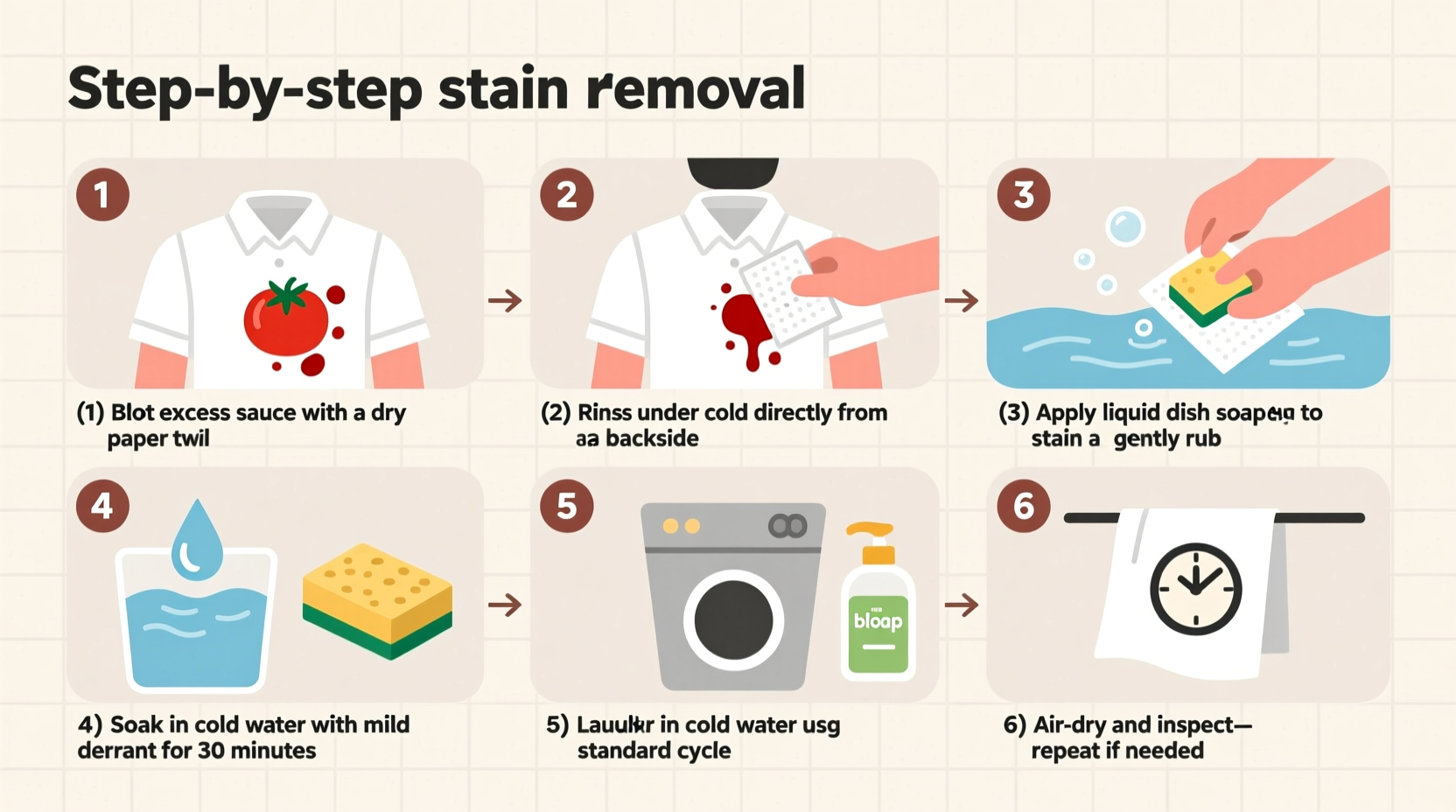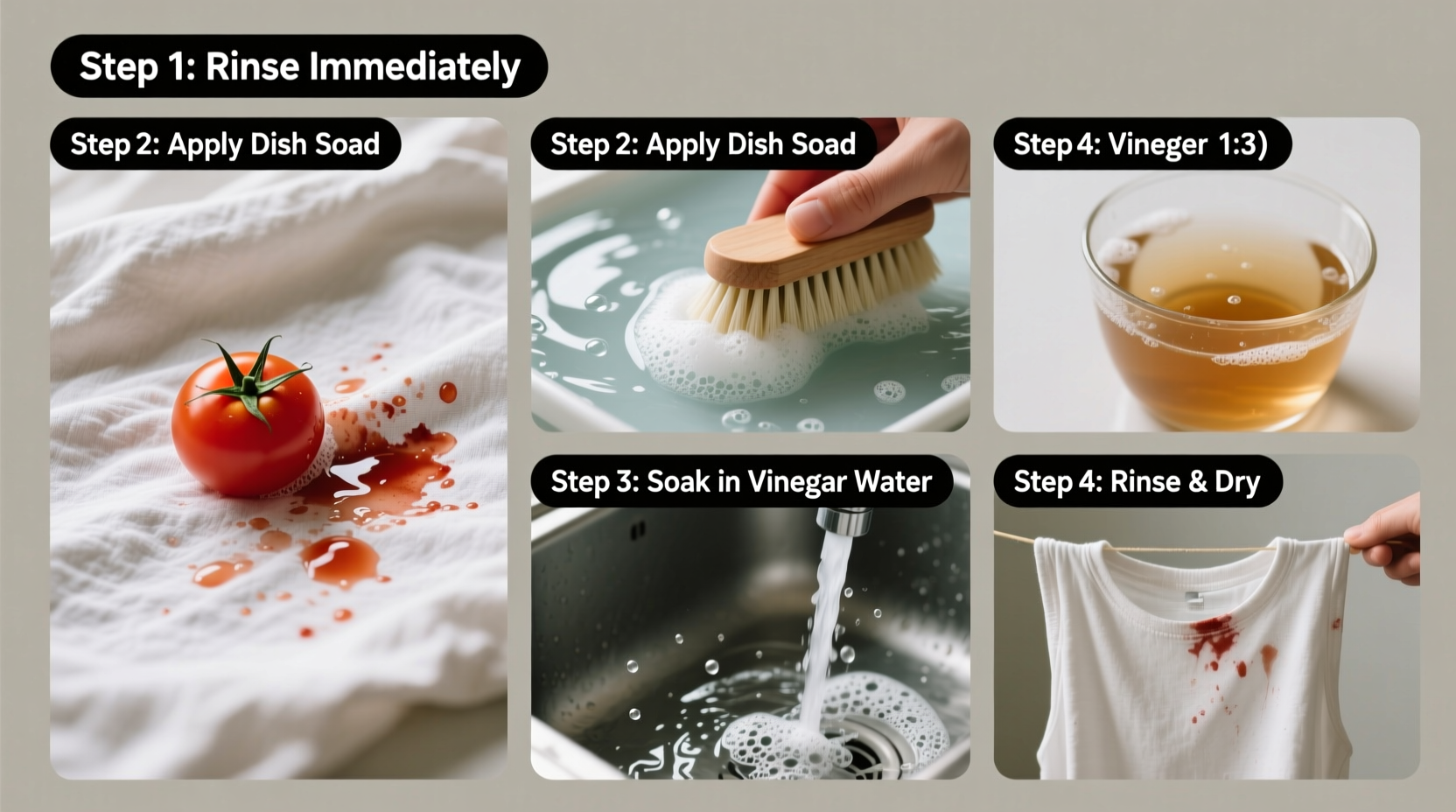Tomato stains present a unique challenge because they contain lycopene, a red pigment that binds tightly to fabric fibers. As a culinary professional who's dealt with countless kitchen mishaps, I've tested these methods across various fabrics and stain ages. The key is understanding that tomato stains combine both protein-based and pigment-based elements, requiring a two-pronged approach for complete removal.
Why Tomato Stains Are Particularly Tricky
Unlike simple water-based stains, tomato contains lycopene—a fat-soluble carotenoid pigment that penetrates deep into fabric. Research from the Textile Society of America confirms that acidic foods like tomatoes set more permanently when exposed to heat, which is why immediate cold water treatment is critical. The longer you wait, the more the lycopene oxidizes and bonds with fabric fibers.
Immediate Response Protocol: The Critical First 5 Minutes
When tomato spills on clothing, your first actions determine whether the stain becomes permanent. Professional chefs know that timing is everything when dealing with food stains.
| Action | Why It Works | Common Mistake to Avoid |
|---|---|---|
| Blot gently with clean cloth | Removes surface tomato without pushing deeper | Rubbing which grinds stain into fibers |
| Rinse under cold running water | Cold water prevents protein coagulation | Using hot water which sets the stain |
| Apply liquid dish soap directly | Breaks down oil components in tomato | Using bar soap which leaves residue |
Step-by-Step Treatment Methods
Method 1: Basic Dish Soap Treatment (Fresh Stains Under 1 Hour)
This professional kitchen standard works for most fresh tomato spills. Liquid dish soap contains degreasers that break down tomato's oil components.
- Apply undiluted liquid dish soap directly to stain
- Gently work into fabric with fingertips for 2 minutes
- Rinse thoroughly with cold water
- Repeat if necessary before laundering
Method 2: Vinegar Solution (Set Stains 1-24 Hours)
Vinegar's acetic acid breaks down lycopene bonds. The American Cleaning Institute confirms vinegar's effectiveness on organic stains.
- Mix 1 part white vinegar with 2 parts cold water
- Soak stained area for 30 minutes (test on hidden area first)
- Gently rub fabric against itself
- Rinse thoroughly before laundering
Method 3: Baking Soda Paste (Stubborn or Dried Stains)
Baking soda's mild abrasiveness lifts set stains without damaging fibers. This method works particularly well on cotton and linen.
- Create paste with 3 parts baking soda to 1 part water
- Apply thickly to stain and let sit 1-2 hours
- Gently brush with soft toothbrush
- Rinse thoroughly with cold water

Fabric-Specific Treatment Guide
Different fabrics require tailored approaches. The University of Minnesota Extension program notes that synthetic fabrics often release stains more easily than natural fibers, but require gentler treatment to avoid damage.
| Fabric Type | Recommended Treatment | Special Considerations |
|---|---|---|
| Cotton | Vinegar solution or baking soda paste | Can handle stronger treatments; avoid heat until stain is gone |
| Silk | Dish soap only, minimal rubbing | Never use vinegar or baking soda; professional cleaning recommended |
| Wool | Cold water rinse only | Heat causes shrinkage; seek professional help for set stains |
| Synthetics | Dish soap followed by vinegar | Avoid hydrogen peroxide which may discolor |
When Standard Methods Fail: Advanced Techniques
For stains older than 24 hours, you may need multiple treatments. Consumer Reports testing shows that combining methods yields better results than any single approach:
- Apply dish soap, then vinegar solution, then baking soda paste in sequence
- Allow 30 minutes between treatments
- Rinse thoroughly with cold water after each step
- Repeat entire process if needed before laundering
For white fabrics only, a diluted hydrogen peroxide solution (1 part 3% hydrogen peroxide to 10 parts water) can help break down remaining pigments. Always test on an inconspicuous area first.
Preventing Future Tomato Stains
As someone who's worked in professional kitchens, I've learned that prevention beats treatment:
- Apply fabric protector spray to frequently worn clothing
- Choose darker colors when handling tomato-based foods
- Wear an apron with a plastic backing (not just fabric)
- Keep a stain removal pen in your kitchen for immediate response
When to Seek Professional Help
Delicate fabrics like silk or valuable garments should go to a professional cleaner, especially if the stain has set for more than 48 hours. Explain exactly what caused the stain and what treatments you've already tried—this helps professionals select the most effective removal method without damaging your garment.











 浙公网安备
33010002000092号
浙公网安备
33010002000092号 浙B2-20120091-4
浙B2-20120091-4